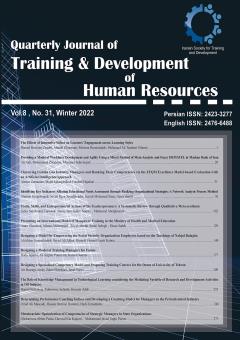طراحی مدل توانمندسازی کارکنان سازمان تأمین اجتماعی بر اساس آموزههای نهج البلاغه
الموضوعات :علی اکبر اسمعیلزاده 1 , سیدعلی اکبر احمدی 2 , حامد فاضلی کبریا 3
1 - گروه مدیریت دولتی، دانشکده علوم انسانی، دانشگاه پیام نور، تهران، ایران
2 - گروه مدیریت دولتی، دانشگاه پیام نور، تهران، ایران
3 - گروه مدیریت دولتی، دانشگاه پیام نور، تهران، ایران
الکلمات المفتاحية: مدل توانمندسازی, آموزههای نهج البلاغه و کارکنان سازمان تأمین اجتماعی.,
ملخص المقالة :
پژوهش حاضر با هدف طراحی مدل توانمندسازی کارکنان سازمان تأمین اجتماعی بر اساس آموزههای نهج البلاغه انجام پذیرفت. براین اساس ابتدا با استفاده از رویکرد تحلیل اسنادی کتاب نهجالبلاغه ترجمه دشتى (1330 ش)، که شامل 625 صفحه و 241 خطبه، 79 نامه و 480 حکمت است، مورد تحلیل قرار گرفت و مواردی را که با مضامین مدنظر همخوانی داشتند استخراج شد. سپس از روی مضامین استخراج شده شاخصها و از روی شاخصها مولفهها انتخاب شدند. تحلیل انجام شده در این پژوهش از نوع تحلیل محتوی کیفی به صورت استقرایی بود. سپس مضامین استخراج شده با استفاده از تکنیک دلفی در اختیار متخصصان قرار گرفت و بعد از تایید دلفی، مدل طراحی شد. برای اعتبارسنجی الگوی طراحی شده، الگوی در قالب پرسشنامه مناسب تدوین و پرسشنامه در اختیار 281 نفر از کارکنان سازمان تامین اجتماعی استان چهارمحال و بختیاری قرار گرفت و سپس نتایج براساس مدل معادلات ساختاری (تحلیل عاملی اکتشافی) مورد تحلیل قرار گرفتند. بنابراین با توجه به تحلیل عاملی 8 عامل و 45 گویه استخراج شده که شامل: عامل اول: استقلال (شامل 4 ماده)؛ عامل دوم: مسولیتپذیری (شامل6 ماده)؛ عامل سوم: خودکنترلی (شامل 8 ماده)؛ عامل چهارم: عزت نفس (شامل 6 ماده)؛ عامل پنجم: اعتمادسازی (شامل 4 ماده)؛ عامل ششم: الگوگیری (شامل 5 ماده)؛ عامل هفتم: دانشافزایی (شامل 6 ماده) و عامل هشتم: انضباط کاری (شامل 6 ماده) است و در نهایت نتایح تحلیل مسیر با استفاده از نرمافزار PLS اسمارت حاکی از برازندگی ساختاری مدل دارد.
1. Kang YJ, Lee JY, Hee wk. A psychological empowerment approach to online knowledge sharing. computers in Human #Behavior. 2017; 74(1);175-187. 2. Wallerstein N. What is the evidence on effectiveness of empowerment to improve health Copenhagen, WHO Regional #Office for Europe .Retrieved from http:// www.euro.who.int / Document / E88086. Pdf. 2006. 3. #Lawler E. Total quality management & employee envolvement: are they compatible, Academy of Management. 1994. 4. #Narayan D. Measuring empowerment, cross-disciplinary perspectives. Washington, D. C: The WorthBank. 2006. 5. Cacioppe R. Structural empowerment: an award-wining program at The Burswood Resort Hotel. Leadership & #Organization Development Journal, 2017;19(5): 264-274. 6. Dickson KE, Lorence A. Psychological empowerment and Job satisfaction of temporary and part-time nonstandard #workers: A preliminary Investigation. Institute and Applied Management. 2019:166-191. 7. Stavrou-Costea E. The challenges of human resource management towards organizational effectiveness, A #comparative study in southern EU. Journal of European Industrial Training. 2015;29(2):112-134. 8. Koberg CS, Boss RW, Senjem JC, Goodman EA. "Antecedentsand outcomes of empowerment: Empirical evidence from
the health careindustry". Group & Organization Management. 2010; 24:71-91. 9. Shah-Heydaripour R, Kamalian AR. Investigating the relationship between organizational justice and psychological #empowerment. Journal of Organizational Culture Management, 2011; 10(1):175-201. 10. #Nahjul -Balaghah Dashti translation (1330 AH). 11. Rezaei Noor J, Zarghami HR, Mamshi Y. Identifying the relationship between knowledge management processes and empowering employees of social security organizations (Case study: Ardabil Social Security Organization). Journal of #Productivity Management. 2014;8(30): 181-153. 12. #Qasemi J. Empowerment in Organizations. Journal of Tadbir. 2009; 132(2): 27-2. 13. Naderian E, Nazari H, Hosseini R. The model of providing the early Islamic community and its implications for new #models. Quarterly Journal of Islamic Economic Knowledge. 2012;6 (2):5-28. 14. #Social Security Organization. Vision document and goals. Supreme Planning and Strategic Council, Tehran. 2018. 15. Feeli J, Gorji Karsami A, Payrvand MH. Investigating the effective factors on empowerment of Sari municipality #employees. Quarterly Journal of Human Resource Management Research. 2018; 10(2) 32: 178-157. 16. MirMohammadi M, Hosseinpour D, Ghasemi Bonaberi HR. Key success factors for employee empowerment. Quarterly #Journal of Improvement and Transformation Management Studies. 2017; 25(83): 114-93. 17. Jafari S, Ahmadi D, Norouzi R. (2017). Investigating the effect of employee empowerment on organizational development with emphasis on perceived organizational support. Quarterly Journal of Organizational Culture Management. #2017;15(1): 9-69 18. Feng T, Wang D, Prajogo D. Incorporating human resource management initiatives into customer services: Empirical #evidence from Chinese manufacturing firms. Industrial Marketing Management. 2014. 19. Delgado A, Korshenko E. Linking employee empowerment and customer perceptions of service quality: Evidence from a #Mexican medical retailing company. 2014. 20. Fernandez S, Moldogaziev T. A Causal Model of the Empowerment Process: Exploring the Links Between Empowerment Practices, Employee cognitions, and Behavioral Outcomes. 11th National Public Management Research Conference, Maxwell #School, Syracuse, New York, June2-4. 2014. 21. Etesami M, Fazeli Kobria A. Codification of the proposed model of social capital management components with a look at #the concepts of Nahjul Balagha. Scientific-Research Journal of Economic Policy-Making,2014; 6(12): 26-45. 22. Ahmadi AA, Darwish H, Sobhanifar Mo.J, Fazeli Kobria H. Modeling of human resource competencies based on the teachings of Nahj al-Balaghah (Case study; Typical measurement of human resource competencies in Imam Sadegh (AS) #University. Quarterly Journal of Management of Government Organizations (Payame Noor), 2013;2(1): 83-108. 23. Ahmadi AA, Darwish H, Sobhanifar MJ, Fazeli Kobria H. Designing a human resource planning model based on #competency based on the teachings of Nahj al-Balaghah. Management Improvement Quarterly, 2013; 8(22): 147-129. 24. Hashemi SS, Alwani SM. Public sector human resource management model in the light of Nahjul Balagha. Law #Enforcement Management Quarterly, 2018; 13(2): 214-181. 25. Ghorbannejad P, Isa Khani A. Competency model of managers based on Nahjul Balagha. Quarterly Journal of #Development and Transformation Management, 2013; 5 (15):22-17. 26. Momeni Rad A, Aliabadi Kh, Faradanesh H, Mazini N. Qualitative content analysis in the research procedure: nature, #stages and validity of the results. Quarterly Journal of Educational Measurement. 2013;14(4): 12-26.


